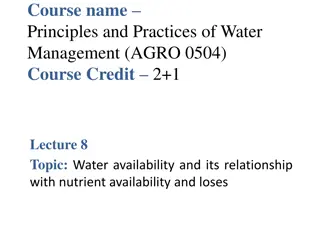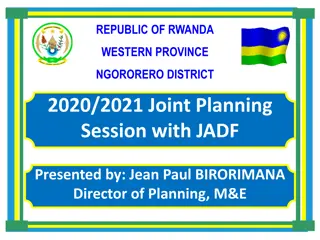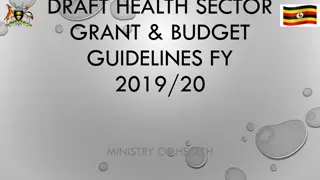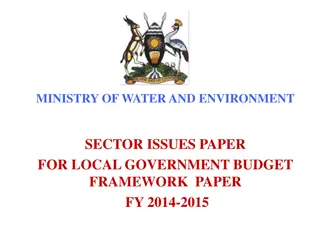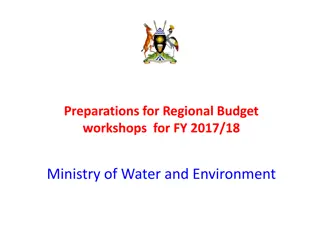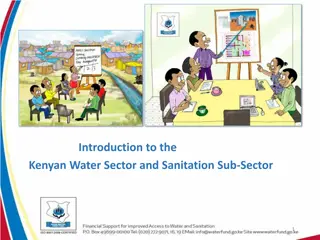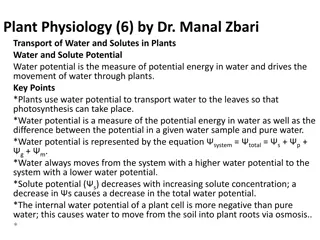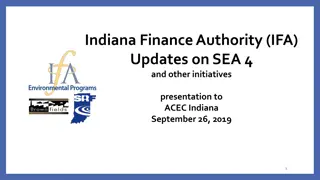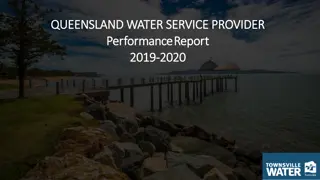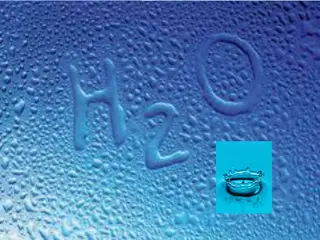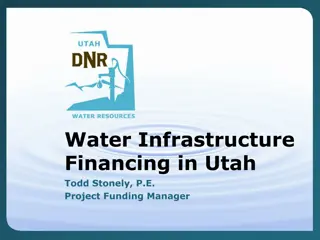Ministry of Water and Environment Sector Priorities FY 2019/2020
This paper outlines the Ministry of Water and Environment's sector priorities and milestones for the upcoming fiscal year. Key focus areas include increasing access to clean water in both rural and urban areas, improving sanitation, and promoting integrated water resources management. The sector also aims to enhance climate monitoring, integrate climate change policies, and expand forest and wetlands coverage. Overall strategic objectives emphasize sustainable water provision, modernizing agriculture, and managing water resources for future generations.
Download Presentation

Please find below an Image/Link to download the presentation.
The content on the website is provided AS IS for your information and personal use only. It may not be sold, licensed, or shared on other websites without obtaining consent from the author. Download presentation by click this link. If you encounter any issues during the download, it is possible that the publisher has removed the file from their server.
E N D
Presentation Transcript
Ministry of Water and Environment Sector Issues Paper for the Regional Budget Consultations Workshops for FY 2019/2020 17thSeptember -2ndOctober 2018
Structure of the Presentation 1. 2. 3. Policy priorities/Sector objectives Sector Linkage to National Development Plan II (2015-2020) Response to issues raised by the LGs during 2018/19 LG- Budget Consultations Structure and Purpose of Sector Transfers Budget Requirements Specific Sectoral Budget Issues 4. 5. 6.
Sector Priorities and Milestones The Sector priorities are aimed to achieve the Vision 2040, NDPII, the NRM-Manifesto-2016/21 in totality as well as the SDGs) especially Goals 6, 13 and 15. 1. Increase access to clean and safe water in rural areas from the current 70% to 79 % (2019/20) within a radius of 1Km with the aim of providing a water source in every village. 2. Increase access to clean and safe water in urban areas from the current 64% to 100 % (2019/20) by increasing piped water coverage in both small and big towns. 3. Increase access to improved sanitation in rural areas from 80% to 100% (2019/20) and from 77% to 100% (2019/20) for urban areas. 4. Promote Integrated Water Resources Management in all development activities for sustainable water resources country-wide. 5. Improve access to Water for Production and increase cumulative storage from the current 39.3MCM to 55MCM (2019/20) for multipurpose use, including; irrigation, livestock, aquaculture and rural industries through construction and rehabilitation of large and small water reservoirs.
Sector Priorities and Milestones 1. Increase automation of climate monitoring network from 10 percent to 40 percent by 2019/20. 2. Integrate climate change policy interventions in all sector development plans. 3. Increase the country s forest cover from 10% to 18% by 2019/20. through massive tree planting of 100-200 million trees annually country wide 4. Increase the country s wetlands cover from 10.9% to 12% by 2019/20. through restoration and demarcation of wetlands.
Sector objectives The overall Strategic objectives for Water and Environment Sector are: 1. To provide sustainable provision of safe water within easy reach and hygienic sanitation facilities, based on management responsibility and ownership by the users, Promote development of water supply for agricultural production in order to modernize agriculture and mitigate effects of climatic variations on rain fed agriculture To manage and develop the water resources of Uganda in an integrated and sustainable manner, so as to secure and provide water of adequate quantity and quality for all social and economic needs of the present and future generations with the full participation of all stakeholders and To increase productivity of the natural resource base and harnessing natural resources in a sustainable manner 2. 3. 4. 5
Key Sector Outcomes Indicators Outcome 1: Increased access to quality safe water and sanitation facilities for rural, urban water for improved production and livelihoods by women an men. Outcome 2: Increased provision and utilization of WfP facilities to enhance production and productivity and socio-economic transformation by women an men. Outcome 3: Improved and adequate water quality and quantity for all water users in the country. Outcome 4: Improved weather, climate and climate change management, protection and restoration of environment and natural resources.
Relations between National Development Plan (NDP-II) and Sector Objectives Over the NDP period, therefore the Water and Environment sector implementation of sector priorities and objectives, interventions, outcomes, targets aimed at increased access to safe water and sanitation in rural and urban areas, increased water storage for multi-purpose use, and promotion of sustainable utilization of natural resources for improved livelihood in the country. will focus on
Responses to issues raised in the LGBF Consultative workshop for FY 2018/19 1. MWE expedites the development of the irrigation policy and strategy Response: The National Irrigation Policy was approved by cabinet on 12th/02/2018 and is operational. The policy sets out a goal of ensuring sustainable availability of water for irrigation and its efficient use for enhanced crop production, productivity and profitability to contribute to food security and wealth creation.
Responses to issues raised during the LGBF Consultative workshop for FY 2018/19 2. Government needs to explore possibilities of setting up and encouraging irrigation plants Response: The target is to achieve 3,030,000 Ha by 2040. So far MWE has increased irrigation potential to 15,046.9Ha. The MWE construction 04 medium size irrigation schemes of Agoro in Lamwo district (650ha); Doho in Butaleja District (1000ha) and Mubuku in Kasese district (516ha). Construction of Olweny irrigation scheme in Lira district, Rwengaaju and Kabarole district irrigations schemes is in progress. Commenced construction of 04 medium scale irrigation schemes of Mubuku II in Kasese, Ngenge in Kween, Doho II in Butaleja, and Tochi in Oyam district. Completed construction of 16 small scale irrigation systems in Bugiri, Soroti, Abim, Amuria, Kaabong, Napak, Oyam, Alebtong, Lira, Nwoya, Lwengo, Mbarara, Isingiro, Mukono, Rukiga and Masaka.
Government needs to explore possibilities of setting up and encouraging irrigation plants (cont) Construction of 21 irrigation systems is ongoing in the districts of Katakwi, Kaabong, Ngora, Kamuli, Bukedea, Iganga, Tororo, Kaberamaido, Bushenyi, Mubende, Lyantonde, Mityana, Gulu, Zombo and Adjumani. MWE has 13 sets of construction equipment (comprising of a bulldozer, excavator and Tipper truck) which are accessed through the deconcentrated Water for Production facilities in North, East and West regions. The equipment is accessed through a subsidized cost by the farmers. To date MWE has constructed over 900 valley tanks under this arrangement since 2008. MWE constructs communal WfP facilities in Karamoja sub- region due to challenges of O&M while in the western region more private WfP facilities have been constructed because farmers are willing to contribute to O&M of their facilities.
Responses to issues raised in the LGBF Consultative workshop for FY 2018/19 3.Government considers combining irrigation matters under one Ministry Response The national Irrigation Policy clearly distinguishes the roles of each MDA in terms irrigation. MWE is responsible for off-farm activities while as MAAIF on farm activities . Off- farm refers to irrigation infrastructure management. MWE has adopted a policy of Famer Field Schools FFS)- for efficient utilization of WfP facilities. water use and
Responses to issues raised in the LGBF Consultative workshop for FY 2018/19 4. Climate change issues should be streamlined just like how gender issues are streamlined in budget and planning Response: Government issued budget call circulars for 2017/2018 with guidelines to all sectors to mainstream climate change into their annual work plans and budgets The Ministry of Water and Environment issued additional planning guidelines for MDAs to mainstream climate change into sector budgets and plans The outcome of these interventions has however to date not been measured. This will be done within FY 2019/20
Structure and Purpose of Sector Transfers Grant Purpose Non-Wage Conditional Grant o/w Rural Water and Sanitation Deliver sanitation and hygiene outreach and information dissemination around water points; management of the water sector. Funds earmarked for protection of wetlands, demarcation, restoration and enforcement of wetlands laws and regulations in LGs. o/w Natural Resources & Environment Development Conditional Grant Water and Environment Provision and rehabilitation of rural water infrastructure that enables access to clean and safe water. Transitional and Support Services Grant o/w Support Services Non-Wage Recurrent - Urban Water Funds the O&M of piped water systems in towns within a district, bridging the gap between local revenue collection and operation costs. o/w Transitional Development - Sanitation This fund is earmarked for sanitation activities in a 83 districts. 13
Key Variables Used in Allocation Formulae Variable name RWS NW NRM NW Devt Weightings Justification Fixed Allocation 82 0 30 To cover the fixed costs of a District Water Office and ensure a minimum investment allocation for each local government. Rural Population Served 0 0 20 To cover the operation, maintenance and rehabilitation of existing water supplies Rural Un served Population for SCs with Coverage below 77 per-cent capped at 50,000 0 0 45 This adds weight to the most under-served areas within a local government, to target funding to areas which are most lagging behind the sector target. The figures are capped, to limit the total availability of funding to LGs and ensure absorption of funds. Estimated Cost of Providing Per Capita 0 0 5 The cost of delivering water facilities varies greatly across the country due to geographical and other factors. This indicator compensates for these variations. Water Land Area 10 5 0 Land area is considered a proxy for the scale of natural resources management activities Population Hard Hard to Stay Areas in 3 2 0 Those areas which are hard to reach are more costly to deliver services to and therefore are given priority. to Reach Rural Population 5 83 0 Indicator of scale of rural water and sanitation services required. Similarly for the environment sector. The higher the population the more people requiring services. Poverty Headcount 0 10 0 This is used as a proxy for need for natural resource management services, targeting allocations on the poorest areas. 14
Overview of Budget Requirements for 2019/20 (1/n) Budget Requirements Summary of Budget Principles and Requirements Narrative performance contract and The budget narrative summarises information on revenue, expenditure and key outputs in the performance contract. The budget must adhere to the guidelines. Overview of Work plan Revenues Expenditure Total Work plan revenues and expenditures balance and are divided correctly between wage, non-wage recurrent, GoU and donor development. and The following positions must be budgeted for under the water department: 1 Water Engineer, 1 Engineering Assistant (Water/Borehole Technician), Assistant Water Officers Salaries and related costs If these posts are not funded from the unconditional wage grant, they should be budgeted for as contract staff in the development budget funded from the sector development grant.
Overview of Budget Requirements for 2019/20 Budget Requirements Lower Services (O&M piped water systems in settlements/R GCs) Summary of Budget Principles and Requirements In line with allocations to the support services grant- urban water, allocations should be made to urban settlements and RGCs. Local The full amount of grant allocations from the Support Services Urban O&M grant should be allocated as Lower Local Services to the piped water schemes and umbrella organisations identified by MWE. Urban Routine maintenance, including minor repairs, remains the responsibility of communities and associated water user committees within each sub-county. Note that this is only applicable to LGs receiving the Support Services Grant for Urban Water. A minimum of 40% of the non-wage recurrent budget for rural water and sanitation should be allocated to: o Promotion of sanitation and hygiene o Mobilisation and promotion of community based maintenance of water sources. For those local governments receiving funds from the Transitional Development Sanitation grant, additional allocations should be made in the development budget to sanitation activities. Higher Local Services (Promotion of sanitation hygiene and community- based mobilisation) ,
Overview of Budget Requirements for 2019/20 Summary of Budget Principles and Requirements Budget Requirements Up to 40% of the non-wage recurrent budget of for rural water and sanitation should be allocated to: o The operation costs of District Water Offices o Coordination activities o Routine monitoring of water sector activities Overall, the non wage recurrent budget that caters for management, monitoring and administration of service delivery does not exceed 14% of the total of both the Development and Recurrent budget. Monitoring, management and administratio n of service delivery No funds from sector conditional grants can be spent on capacity development (for staff). Training and capacity development will be provided by the centre. LGs may also provide for capacity development using their own local revenue, the DDEG, and other transfers. Capacity building activities should be consistent with the positive and negative lists (A table listing these is part of these guidelines) Capacity Development
Overview of Budget Requirements for 2019/20 Budget Requirements Summary of Budget Principles and Requirements Overall, a maximum of 15% of the Sector GoU development Budget for the Water Department can be allocated to rehabilitation or major repair of water sources at both the sub-county and district levels. A minimum 80% of the sector GoU development budget should be allocated to capital such as infrastructure, facilities and equipment. Specific facilities include: Water sources/points, Public toilets, Dams All sub-counties with water coverage below the national target level should be allocated at least 75% of their share of the cost of achieving the sector target. Up to 5% of the value of sector infrastructure investments can be allocated to investment servicing costs, including feasibility studies, procurement and monitoring costs. Local governments may not budget for activities specified in the negative list for capital investment (see table below). LGs must receive written authorisation from MWE to budget for office construction and other administrative investments, funded from the sector development grant . Development Investments
Allocation of the WDCG Starting FY 2018/19, the Development Grant allocation formula was based on two principles: i. Basic allocation criteria of 50% of the grant. i. The remaining 50% of the grant allocation based on performance assessment report. The OPM conducted a joint LG assessment with stakeholders. The findings will determine the allocation of 50% of the remaining grant.
Allocation of the WDCG Performance component of the allocation formula The impact from the results of the assessment will be weighted (scaled) with the basic formula to ensure that every performance indicator has a noticeable impact on the actual size of the allocations and that the system provides incentives for all (larger as well as smaller LGs). The system will ensure that LGs with a performance score above the average score will receive additional funding and a LG with a score that is below the average will be allocated less resources. The system also ensures that all the funds are allocated (no balances). The details have been programmed in OTIMs which is a function of the PBS.
Specific Policy Issues for Consideration during FY 2019/20 Issues Required Action LGFC shall submit to MFPED its request regarding the need to increase the Water Sector budget especially on the non-wage recurrent requirements. Likewise MWE shall request MFPED to increase funding for the entire Water Sector. Increase allocation Sanitation Development Grant from 8% to 14 %. LGs noted that the stock of water sources infrastructure has increased tremendously and the provision for operation and maintenance was no longer adequate. of and Recurrent District Expenditure Water and Inequitable distribution of water sources. LGs should prioritize the provision of water sources to the villages where there is no water source and ensure that at least each village has a clean and safe water source . LGs should indicate the number of villages in each district and how many will be served in the medium term period. Database on access to safe water in the country indicated that the extra new facilities were being concentrated in the same areas already served with water facilities, leaving a number of other areas underserved. This is against the Ministry s principle of "Some for more rather than more for some" that promotes equity. MWE reported that out of over 60,000 villages, 19,791 still lack access to water. 21
Specific Policy Issues for Consideration during FY 2019/20 Issues Required Action LGs should prioritize the purchase of vehicles to be used for monitoring and supervision of water works using the available discretionary resources and not through the conditional water sector grant. Vehicles for District Water Offices and construction of Water Offices. Following the ban on purchase of vehicles by Government and considering the reduced funding to the local governments through the rural water grant, transport for the DWOs has become a big challenge. LGs should also consider procurement of motorcycles since they are cheaper and easy to use in the field. MWE shall continue to lobby other donors to fund vehicle purchase. Use of district groundwater maps in planning and implementation of water supply projects. MWE shall continue to provide the regional groundwater maps to the regional offices and the LGs shall in turn access the district maps from the respective regions.
Other Issues for the Water & Environment Sector Issues Issues Required Action Required Action Management of Contracts for Water Projects LGs Accounting Officers should appoint Water Officers as contract managers for water projects in line with the performance contract of the CAOs. Managemnet of Contracts for Water Projects It was reported that some districts were not appointing water officers as contract managers for all water works. water officers as contract managers for all water works. MOWE shall issue a circular to Local Governments reminding them of appointing Water Officers as contract managers for water works. Local Government Accounting Officers shall appoint Water Officers as contract managers in line with the performance contract of the CAOs. position of budget provision for staffing in District Water Offices . Some districts were not appointing LGs should consult MFPED and MoPS on the Staffing in District Water Offices. Recruitment of District Water officers in the LGs still remains a challenge. There is a staffing challenge in 45 districts where 17 officers are doubling as District Engineers and 25 officers are in acting positions and 3 offices are vacant. In the meantime MWE will continue to assist LGs with staffing challenges on case by case basis.
Specific Policy Issues for Consideration during FY 2019/20 Issues Required Action Borehole Designs and Specifications . MWE has shifted from construction of Hand Pumps to Solar powered Mini-Piped Water Schemes. LGs are encouraged to adopt to this technology and construct boreholes of at least 6 diameter that can be converted to solar power system. Development of Solar powered Mini-Piped Water Schemes to supply more persons than otherwise would be served using the traditional hand pumps. Design of programmes LGs are mandated to participate in all interventions undertaken within the district. MWE will involve the LGs from the identification stage procurement, monitoring and evaluation of projects and programs ownership and sustainability. There is concern of limited involvement of the LGs in programme design, implementation, evaluation. through design, monitoring and to promote MWE should design projects in conjunction with LGs, and have joint evaluations and supervision. MWE will carry out capacity needs assessment and thereafter involve LGs in the design and implementation of the strategies.
Specific Policy Issues for Consideration during FY 2019/20 Required Action Issues Environment and Natural Resources Grant allocation. MWE developed its Sector Development Plan (SDP) with Key Performance Indicators. LGs are encouraged to make use these KPI when formulating their DDPs. LGs are encouraged to develop Data Banks for purpose of strategic planning, evaluation and policy guidance. MWE has not given the due emphasis on environment and natural resources in terms of indicators and funding. No data collection mechanisms are in place to support LGs to show the economic contribution to the people and the economy. MWE will continue mobilizing additional resources to be allocated to the Environment sub sector. In the meantime MWE is implementing a project Building Resilient Community and Equal Systems through Restoration of Wetlands and Associated Catchments in Uganda The project cost is over USD 44 million. Covering 10 districts in South Western Uganda i.e. Kabale, Kisoro, Kanungu, Rukungiri, Greater Bushenyi and Ntungamo. 10 districts in Eastern Uganda (i.e. Pallisa, Kibuku, Bukedea, Namtumba, Butaleja, Budaka, Toror, Kaliro, Ngora and Mbale. Other projects include FIEFOC. Whereas the MFPED guidelines provide for a consolidated grant for each sector, the Natural Resource Office has one grant dealing with wetlands only neglecting all the other sectors environment, climate change) (land, forestry, A concept paper on Strengthening ENR at LG level is being developed and expected to be ready by end of June 2019.
Specific Policy Issues for Consideration during FY 2019/20 Issues Required Action Deforestation LGS should formally recommend to MWE individuals or companies to be licensed for tree cutting and for transportation of forest produce. Indiscriminate cutting of trees and destruction of rear species in the name of Charcoal and logging. The challenge here is that a larger percentage of people destroying/cutting indiscriminately are the bigshots in government e.g. in Gulu when the District Chairperson impounded trucks loaded with charcoal he was called by a high ranking officer to let the trucks go. MWE should license or permit dealers upon recommendation from LGs . those trees Cancellation Whereas the MWE has done a great job in cancellation of titles in wetlands, still there is little information on how many tittles in wetlands/ forets are cancelled, and when titles are cancelled, who are they transferred to. The cancelled titles are not publicized. of titles in Wetlands/forests MWE shouldshare the land cover map for wetlands with all LGs by December, 2018. MWE shouldprovide LGs with details of the titles cancelled, appeals and those that passed the appeal by December, 2018. LGs should direct the Land Boards to refrain from leasing forest reserves developments. A list of all concelled titles will be published. and wetlands for
Specific Policy Issues for Consideration during FY 2019/20 Issues Required Action Solid waste management MWE is in the process of reviewing the waste management regulation to streamline wste management in the ountry. LGs are encouraged to provide their views in this process. This is still a challenge in most urban. NEMA is in process of reviewing the Management Regulations to streamline roles of waste generators, stewards, handlers and authorities including LGs. Waste The ban on use of kavera is still on. Government through NEMA shall continue to implement the ban on polythen bags. In the meantime NEMA has adopted a soft approach campaign strategy of on radios and TV populary known as Tuvekukaveera . It is intended to educate and sensitize communities on the dangers of kaveera. LGs are encouraged to sensitize the communities at all levels. NEMA recieved funding from government to recruit additional 35 staff effective FY 2017/18 which has been done. In addition, NEMA has opened up 3 more regional offices in Mbarara, Mbale and Lira and strengthened the regional office in Masindi. This is intended to take services closer to the population. NEMA s capacity needs to be strengthened
Specific Policy Issues for Consideration during FY 2019/20 De-concentrated Structures The Ministry has established de-concentrated structures to improve on the service delivery country wide such as Water for Production: Mbale covering Eastern and Kalamoja region, Lira covering Northern, West Nile, Bunyoro and Northern part of the central region and Mbarara covering South- west, Western and southern part of the central region. Others are WSDFs, WMZs, TSUs, Wetlands Regional Coordinators, Organizations. LGs should liaise with these regional centers to all aspects of service delivery beyond district capacities NEMA and Umbrella Management of water catchments and conducting environmental impact assessments Large water related projects are being implemented in districts without assessing the impacts of these projects on the general environment and water resources in particular LGs are required to ensure that water catchments are managed as part of the management of water supply and sanitation infrastructure in order to control activities that may impact on the quality and quantity of water resources. therefore ensure that water catchment management activities and environmental impact assessment studies are reflected in their work plans in future. Districts should
Specific Policy Issues for Consideration during FY 2019/20 Issue Required Action Management Local and Central Forestry Reserves (CFRs) of LGs should manage local forest, community & Private Forest Reserves sustainably because they are buffer to CFRs LGs should partner with NGOs that can provide incentives to local communities who own natural forests because they constitute the largest forest cover LGs should plan to support wood lots at institutional level such (schools, Faith Based Organizations) , projects community level and administrative units. (NFA, SPGS and FIEFOC provide seedlings to : LGs, Operation Wealth Creation, private farmers in LRSs and private land and schools). LGs should follow laws closely while approving issuance of land titles
Specific Policy Issues for Consideration during FY 2019/20 Issue Required Action Management of Local and Central Forestry Reserves (CFRs) in the District, through proper consultations of all stakeholders Encourage people to plant trees on private and public land -NFA is in a campaign to encourage tree-planting (Community Tree Planting Programme). NFA and DFRs need to work in close collaboration to increase tree cover. Incitement of encroachers should be discouraged to enable NFA effectively stop destruction of forest reserves and restore them through tree-planting. Boundary Demarcation DLGs should cooperate with MWE/NFA in operating the forest reserves boundaries that were allocated o private tree farmers for proper planning (i) restore degraded critical wetlands, (ii) demarcate critical wetlands and (iii) carry out regular compliance monitoring and enforcement to deter further degradation. Wetland Degradation DLS are encouraged to Nationally, the rate of wetland continue to increase at an alarming speed degradation
Conclusion The sector is committed to achieving NDP-II objectives, the NRM Manifesto commitments as well as the Seven Presidential (7) Strategic Guidelines for Water and Environment aimed at transformation of the country to middle income status by 2020. During FY 2019/20 the W&E Sector will continue to focus on equity, quality and efficiency in its service delivery in order to enhance access to clean water and sanitation plus a clean and healthy environment. This requires collective effort by all actors including the LGs to contribute to the attainment of the targeted development goals for Water and Environment, as stipulated in the NDPII and the NRM Manifesto 2016/21.






